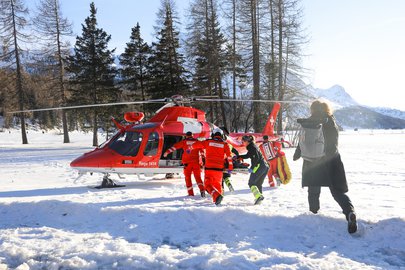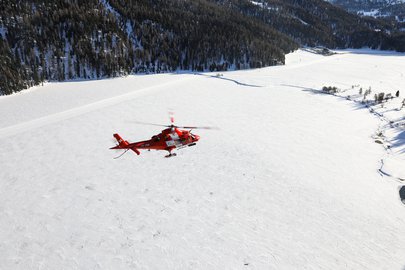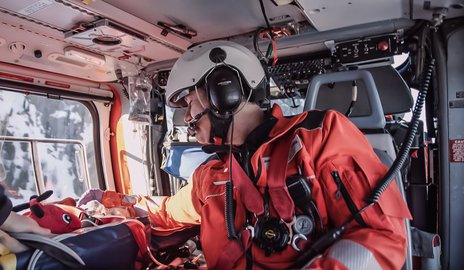Another sunny winter day is drawing to a close. The Engadin ski slopes are gradually emptying as the Rega crew from the Samedan base are called out on a mission. Often on days with good weather, the crew are constantly deployed to help injured winter sports enthusiasts. However, this mission does not take the crew to a ski resort: in the centre of Sils (Canton Graubünden), a small boy has had an accident and urgently needs Rega’s help. This is all the crew know when, at the Rega base in Samedan, pilot and head of base Giorgio Faustinelli starts the helicopter’s engines and shortly afterwards takes off in a south-westerly direction towards the village on Lake Sils, just a few flying minutes away
Mission details during the flight
In the air, the uncertainty eases somewhat when the crew of Rega 9 – as the Engadin rescue helicopter is known – receive further details of the mission from the Rega Operations Centre, such as the precise coordinates of the accident site. This information is not communicated by radio, as in the past, but directly on the electronic flight bag (EFB), a special tablet computer with which the crew can call up information about the mission and the patient, as well as the current flight weather data and extensive map material.
On the approach flight
Still in the air, during the final approach to the accident site, the crew of the rescue helicopter spot the rescue service vehicle in a side street near the hotel. The police patrol that has been called out has stopped the traffic in the small street so that the helicopter is able to land safely. Pilot Faustinelli opts for a landing site in the snow next to a cluster of trees a few metres from the road and gently sets the rescue helicopter down on the ground.
Cooperation at the accident site
Rega emergency physician Joachim Koppenberg immediately heads for the ambulance, where the young patient is being attended to by the local paramedics. While playing at the hotel, four-year-old Aaron had climbed over the railing of a balcony and fallen from a height of four metres onto a carpet. He is bleeding from the head. It is unclear whether he has also sustained internal and therefore undiscernible injuries. The hotel staff had immediately called the neighbouring GP to ask for help and alerted the emergency services. There followed a prime example of the well-functioning collaboration between the various operation partners, who all worked hand in hand: it quickly became clear to the GP, who was the first to examine the boy in the presence of his worried mother, and the paramedics that due to the height of the fall, Aaron needed to be transported to a central hospital as quickly as possible. Falls from a height are often the cause of several injuries occurring simultaneously. Such multiple injuries, known as polytrauma, are usually treated in a shock room, which is part of the casualty department of a main hospital. The shock room is used for the initial treatment of severely injured patients by specialists from various fields. Rega’s services are required to fly Aaron swiftly and gently to hospital.
Taking charge of the child at the accident site
"The other medics had already administered first aid to the boy and informed me of the circumstances of the accident and the boy’s condition," relates Koppenberg. However, when he arrives at the scene of an accident and takes charge of a patient who has already received initial medical care, it is important that he always makes his own assessment of the casualty’s state of health, Koppenberg explains. After all, the condition of a person who has had an accident or become acutely ill can change constantly.
Flight to Chur
Apart from a laceration and bruising, there is nothing to show that Aaron had had an accident. But in the meantime he has become noticeably quieter and more introverted than he was shortly after the fall. Drowsiness or apathy can be symptoms of a more severe concussion, especially in small children. "At that time, we could not rule out serious injuries to the head or other internal injuries. Therefore, the only place for Aaron to receive further treatment was the nearest main hospital in Chur." If Aaron’s condition were suddenly to worsen, the hospital offered the most treatment options and also had a paediatric intensive care unit. If patients need to be flown to a main hospital, the distances are often longer. It is therefore important to ensure that central hospitals can also be easily reached from peripheral regions, such as the Engadin, in all weather conditions.
Taking to the air with a helicopter soft toy
While emergency flight physician Joachim Koppenberg and paramedic Peter Caviezel prepare the stretcher carrying little Aaron for takeoff, pilot Giorgio Faustinelli informs the Rega Operations Centre about the destination hospital and the suspected diagnosis. The flight coordinator at the other end of the line will register Aaron at the Cantonal Hospital in Chur. The hospital staff can then prepare for the young patient’s arrival and attend to him in the shock room. Aaron’s mother is also flying with him. "If it is possible to take a parent with us, we do so," says Koppenberg. It is especially important for young patients to have a familiar face with them in the helicopter and subsequently in the hospital, he explains. In this unfamiliar situation, it gives the child a sense of security. At the front of the helicopter, in the cockpit, Faustinelli starts getting ready for takeoff, while behind him in the cabin, Koppenberg places a small helicopter soft toy on the stretcher where Aaron can see it. The emergency physician uses it to playfully demonstrate to the little patient how the real helicopter is about to take off and will later land, to dispel his fear of flying. The sky is cloudless and so there is nothing to stand in the way of a swift and gentle transport from the Engadin over the Julier Pass to the hospital in Chur.
Landing in Chur
After the approximately 20-minute flight, Faustinelli sets down the AgustaWestland Da Vinci helicopter on the landing pad of the Cantonal Hospital in Chur. In the shock room, Joachim Koppenberg informs the waiting hospital staff about the circumstances surrounding the accident and the first aid that has already been provided, and then hands over the young patient for further tests and treatment. Later, the Rega physician is to learn that Aaron had not sustained any internal injuries and that he should fully recover from his fall. On the flight back to the Engadin, the evening sun slowly sinks below the horizon and bathes the mountain peaks in a golden light. But for Giorgio Faustinelli, Peter Caviezel and Joachim Koppenberg, the day is far from over: after darkness has fallen, they will fly another patient from the Engadin to the Cantonal Hospital in Chur.


